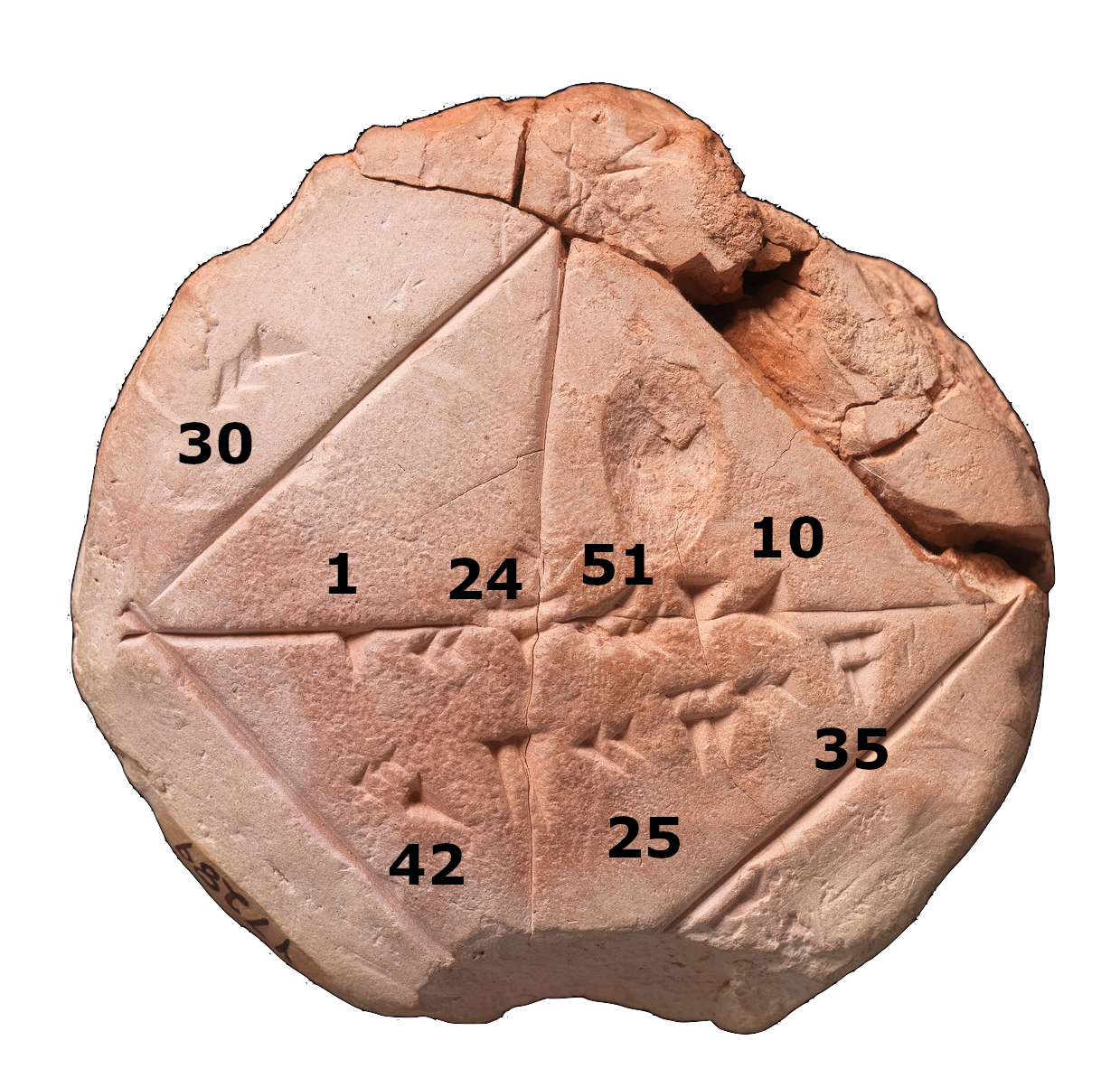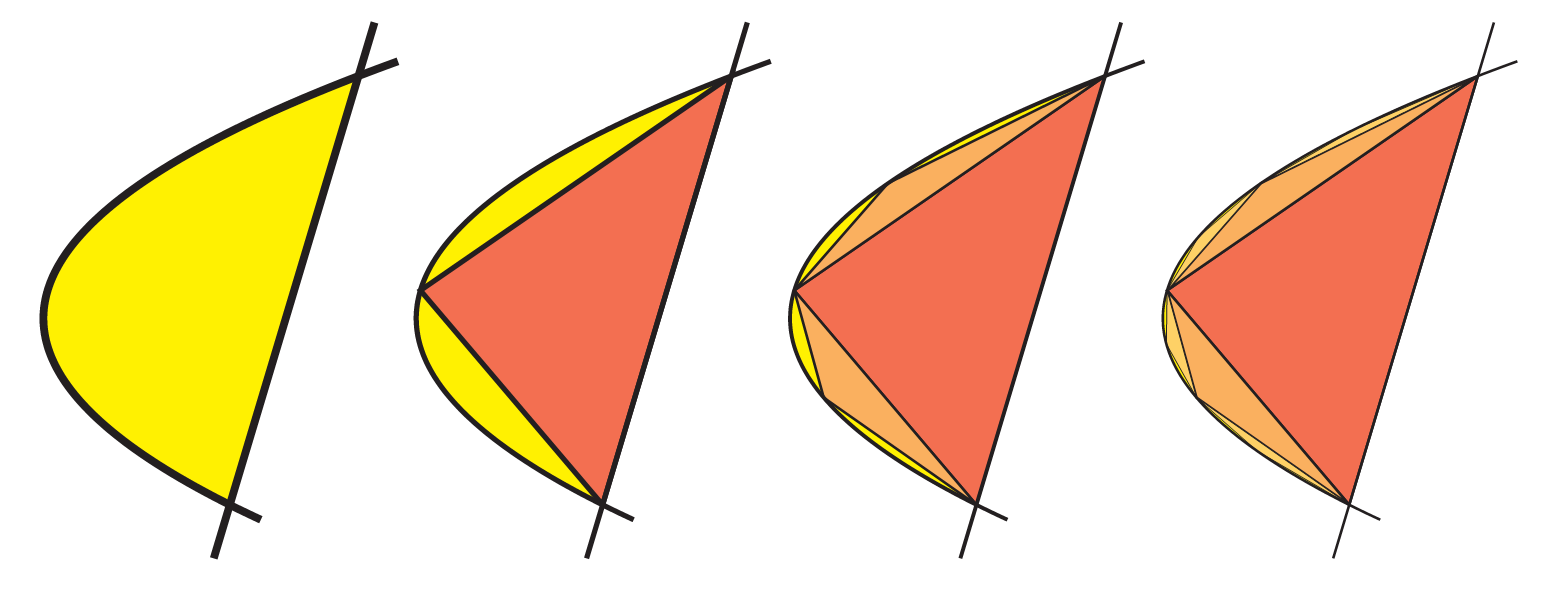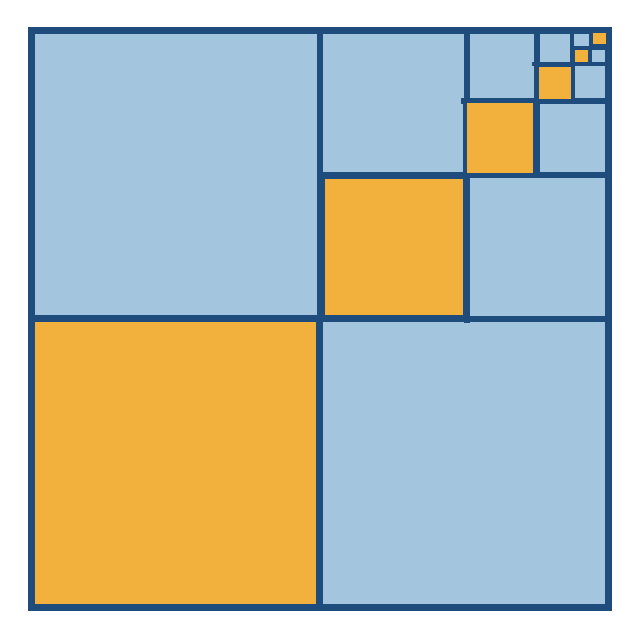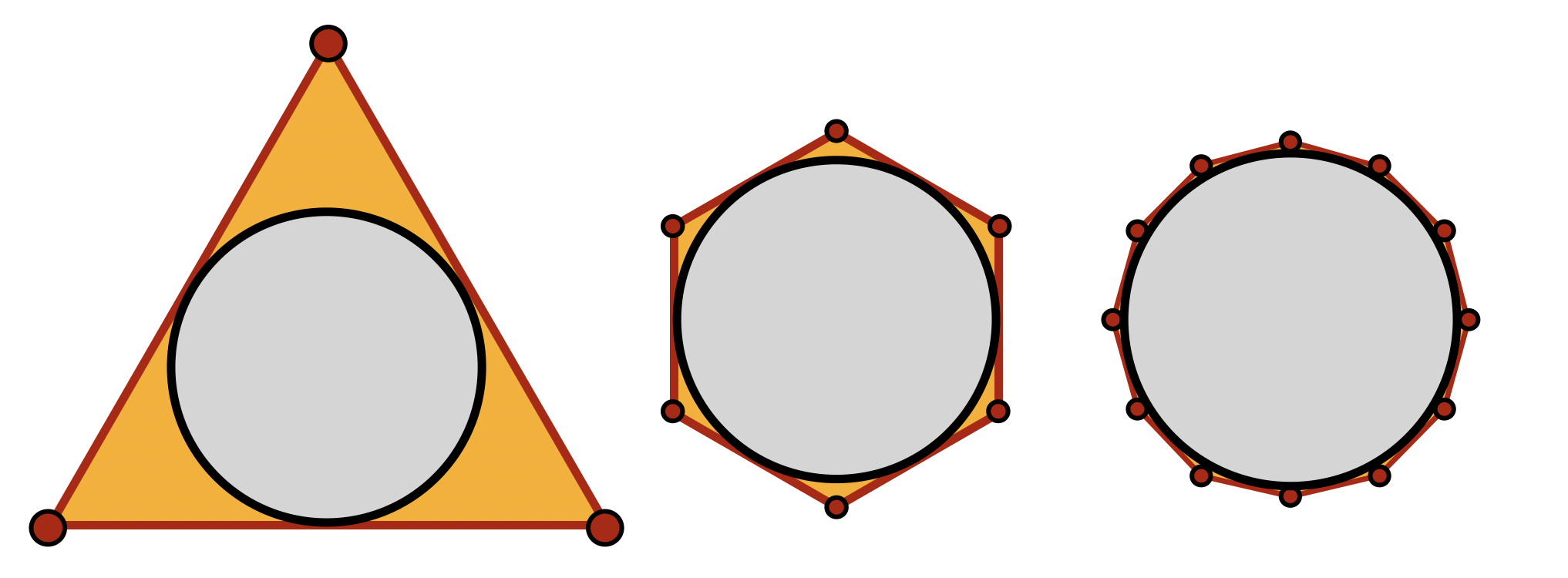1
1.1 The Diagonal of a Square
Around 3700 years ago, a babylonian student was assigned a homework problem, and their work (in clay) fortuitously survived until the modern day.

The problem involved measuring the length of the diagonal of a square of side length
Definition 1.1 (Base Systems for Numerals) If
Numbers between
The babylonians used base
Which, in base 60 denotes
Exercise 1.1 By inscribing a regular hexagon in a circle, the Babylonians approximated
The tablet itself does not record how the babylonians came up with so accurate an approximation, but we have been able to reconstruct their reasoning in modern times
Example 1.1 (Babylonian Algorithm Computing
Starting from a rectangle with side lengths 1 and 2, applying this procedure once improves our estimate from
Exercise 1.2 (Babylonian Algorithm Computing
Exercise 1.3 (Computing Cube Roots) Can you modify the babylonians procedure which found approximates of
Here, instead of starting with a rectangle of sides
Start with a simple rectangular prism of volume
It is clear from other Babylonian writings that they knew this was merely an approximation, but it took over a thousand years before we had more clarity on the nature of
1.1.1 Pythagoras
We often remember the Pythagoreans for the theorem bearing their name. But while they did prove this, the result (likely without proof) was known for millennia before them. The truly new, and shocking contribution to mathematics was the discovery that there must be numbers beyond the rationals, if we wish to do geometry.
Theorem 1.1 (
To give a proof of this fact we need one elementary result of number theory, known as Euclid’s Lemma (which says that if a prime
Proof. (Sketch) Assume
Thus, we can write
But now we’ve found that both
Exercise 1.4 Following analogous logic, prove that
Knowing now that
Definition 1.2 (The Babylonian Algorithm and Number Theory) Because
Exercise 1.5 (The Babylonian Algorithm and Number Theory) Prove that all approximations produced by the babylonian sequence starting from the rectangle with sides
To acomodate this discovery, the Greeks had to add a new number to their number system - in fact, after really absorbing the argument, they needed to add many. Things like
1.2 Quadrature of the Parabola
The idea to compute some seemingly unreachable quantity by a succession of better and better approximations may have begun in babylon, but truly blossomed in the hands of Archimedes.
In his book The Quadrature of the Parabola, Archimedes relates the area of a parabolic segment to the area of the largest triangle that can be inscribed within.
Theorem 1.2 The area of the segment bounded by a parabola and a chord is

After first describing how to find the largest inscribed triangle (using a calculation of the tangent lines to a parabola), Archimedes notes that this triangle divides the remaining region into two more parabolic regions. And, he could fill these with their largest triangles as well!
These two triangles then divide the remaining region of the parabola into four new parabolic regions, each of which has their own largest triangle, and so on.

Archimedes proves that in the limit, after doing this infinitely many times, the triangles completely fill the parabolic segment, with zero area left over. Thus, the only task remaining is to add up the area of these infinitely many triangles. And here, he discoveries an interesting pattern.
We will call the first triangle in the construction stage 0 of the process. Then the two triangles we make next comprise stage 1, the ensuing four triangles stage 2, and the next eight stage 3.
Proposition 1.1 (Area of the
If
And the total area
Now Archimedes only has to sum this series. For us moderns this is no trouble: we recognize this immediately as a geometric series
But why is it called geometric? Well (this is not the only reason, but…) Archimedes was the first human to sum such a series, and he did so completely geometrically. Ignoring the leading

He then notes that this is precisely one third the area of the bounding square, as two more identical copies of this sequence of squares fill it entirely (just slide our squares to the left, or down). Thus, this infinite sum is precisely
This tells us an important fact, beyond just the area of the parabola we sought! We were looking to compute the area of a curved shape, and the procedure we found could never give us the answer exactly, but only an infinite sequence of better approximations. Being acquainted with the work of Pythagoras and the Babylonians, this might have well led us to conjecture that the area of the parabola must be irrationally related to the area of the triangle. But Archimedes showed this is not the case; our infinite sum here evaluates to a rational number,
Infinite sequences of rational numbers can sometimes produce a wholly new number, and sometimes just converge to another rational.*
How can we tell? This is one motivating reason to develop a rigorous study of such objects. But it gets even more important, if we try to generalize Archimedes’ argument.
1.2.1 Icarus
Archimedes’ quadrature of the parabola represents a monumental leap forward in human history. This is the first time in the mathematical literature where infinity is not treated as some distant ideal, but rather a real place that can be reached. And the argument itself is an absolute classic - involving the first occurrence of an infinite series in mathematics, and a wonderfully geometric summation method (hence the name geometric series, which survives until today). The elegance of Archimedes’ calculation is almost dangerous - its easy to be blinded by its apparent simplicity, and – like Icarus – fly too close to the sun, falling from these heights of logic directly into contradiction.
Archimedes visualized his argument for the sum
and note that multiplying
Thus,
Call that sum
We can then solve this for
This gives us what we expect when
Amazingly, it even works for negative numbers, after we think about what this means. If
Using our formula above we see that this is supposed to converge to
And, using a computer to add up the first 100 terms we see
This is pretty incredible, as our original geometric reasoning doesn’t make sense for
This is going off to infinity, and our formula gives
As we add this up term by term, we first have 1, then 0, then 1 then 0, over and over agan as we repeatedly add a 1, and then immediately cancel it out. This isn’t getting close to any number at all! But our formula gives
Now we have a real question - did we just discover a new, deep fact of mathematics - that we can sensibly assign values to series like this, that we weren’t originally concerned with, or did we discover a limitation of our theorem? This is an interesting, and important question to come out of our playing around!
Thus far, we haven’t seen any cases where our theorem has output any ‘obviously’ wrong answers, so we may be inclined to trust it. But this does not hold up to further scrutiny: what about when
which is clearly going to infinity. But our formula disagrees, as it would have you belive the sum is
Exercise 1.6 Explain what goes wrong with the argument when
1.3 The Circle Constant
The curved shape that everyone was really interested in was not the parabola, but the circle. Archimedes tackles this in his paper The Measurement of the Circle, where he again constructs a finite sequence of approximations built from triangles, and then reasons about the circle out at infinity. First, we need a definition:
Definition 1.3 (
Archimedes came up with a sequence of overestimates, and underestimates for


Any polygon inside the unit circle gave an underestimate, and any polygon outside gave an overestimate. The more sides the polygon had, the better the approximations would be.
Calculating the area and perimeter of regular

Proposition 1.2 (Area of a Circumscribed Polygon) The area of a regular
Proposition 1.3 (Perimeter of a Circumscribed Polygon) The perimeter of a regular

Proposition 1.4 (Area of a Inscribed Polygon) The area of a regular
Where we used the trigonometric identity
Proposition 1.5 (Perimeter of a Inscribed Polygon) The perimeter of a regular
Using these, Archimedes calculated away all the way to the 96-gon, which provided him with the estimates
This was the best estimate of
Working with the
The lower bound here,
Remark 1.1. The next best rational approximation is
1.3.1 Proving
While impressive, Archimedes’ main goal was not the approximate calculation above, but rather an exact theorem. He wanted to understand the true relationship between the area and perimeter of the circle, and wished to use these approximations as a guide to what is happening with the real circle, “out at infinity”.
To understand this case, Archimedes argues that as
But, now look carefully at the form of the expressions we derived for the circumscribing polygons in Proposition 1.2 and Proposition 1.3:
Here, we do not need to worry about explicitly calculating
- Each polygon is built out of
- The area of a triangle is half its base times its height
- The height of each triangle is 1 (the radius of the circle)
- Thus, the area the sum of half all the bases, or half the perimeter!
But since this exact relationship holds for every single value of
Theorem 1.3 (Archimedes)
1.3.2 Icarus, Reprise
Archimedes again leaves us with an argument so elegant and deceptively simple that its easy to under-appreciate its subtlety and immediately fall prey to contradiction. What if we attempt to repeat Archimedes argument, but with a different sequence of polygons approaching the circle?
Remark 1.2. To be fair to the master, Archimedes is much, much more careful in his paper than I was above, so part of the apparent simplicity is a consequence of my omission.
For example, what if we start with a square circumscribing the circle, and then at each stage produce a new polygon with the following rule:
- At each corner of the polygon, find the largest square that fits within the polygon, and remains outside the circle. Then remove this square.

Exactly like in Archimedes’ example this sequence of polygons approaches the circle as we repeat over and over. In fact, in the limit - this sequence literally becomes the circle (meaning that after infinitely many steps, there are no points of the resulting shape remaining outside the circle at all). Thus, just as for our original sequence of polygons, we expect that the areas and perimeters of these shapes approach the areas and perimeters of the circle itself. That is,
While the behavior of

Since adding a dent does not change the length of the perimeter, each polygon in our sequence has exactly the same perimeter as the original! The original perimeter is easy to calculate, each side of the square is a diameter of the unit circle, so its total perimeter is 8. But since this both does not change and converges in the limit to the circles circumference, we have just derived the amazing fact that
This is inconsistent with what we learn from Archimedes’ argument which shows that
Exercise 1.7 (Convergence to the Diagonal) We can run an argument analogous to the above which proves that
Prove that as
But the pythagorean theorem tells us that its length must be
Its quite difficult to pinpoint exactly what goes wrong here, and thus this presents a particularly strong argument for why we need analysis: without a rigorous understanding of infinite processes and limits, we can never be sure if our seemingly reasonable calculations give the right answers, or lies!
1.3.3 …How did they do it?
With our modern access to calculator technology, the trigonometric formulas above essentially solves the problem: for example, plug in
But this poses a historical problem: of course the ancients did not have a calculator, so how did they compute such accurate approximations millennia ago? And there’s also a potential logical problem lurking in the background: inside our calculator there is some algorithm computing the trigonometric functions, and perhaps that algorithm depends on already knowing something about the value of
To compute their estimates, both Archimedes and Zu Chongzi landed on an idea similar to the Babylonians and their computation of
Exercise 1.8 (The Doublings of Zu Chongzi) How many times did Zu Chongzi double the sides of a hexagon to reach the 24,576 gon?
Following Archimedes, we’ll look at the doubling procedure for the perimeter of inscribed polygons: given
Definition 1.4 (Half Angle Identities)
Also making use of the pythagorean identity
Lets write
This sort of relationship is called a recurrence relation, or a recursively defined sequence as it tells us how to compute the next term in the sequence if we have the previous one. Notice there are no more trigonometric formulas in the recurrence - so if we can find the value
Example 1.2 (A Recurrence for
But, since
The incredible fact: even though we used trigonometry to derive this recurrence, we do not need to know how to evaluate any trigonometric functions to actually use it! All we need to be able to do is find the perimeter of some inscribed
But how can we get started? A beautiful observation of Archimedes was that a regular hexagon inscribed in the circle has perimeter exactly equal to 6, as it can be decomposed into six equilateral triangles, whose side length is the circle’s radius. And with that, we are off!
Example 1.3 (The Perimeter of an Inscribed 96-gon) Since
Using this, we know
Now doubling to the 48 gon,
One more doubling brings us to the 96-gon,
Numerically approximating this gives 6.282063901781019276222, which is more recognizable to us if we compute the half perimeter:
Exercise 1.9 Find a recurrence relation for the area
Exercise 1.10 Let
Hint: you’ll need some trig identities to write everything in terms of tangent! Use this to find a recurrence relation for
After all of this are still left with a fundamental question: what sort of number is